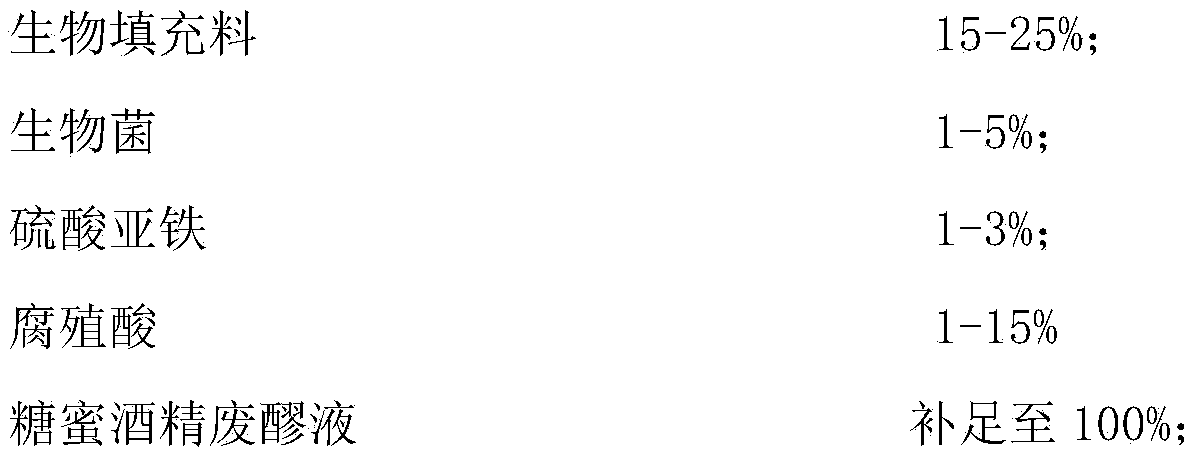Biological organic fertilizer for planting lotus roots
A bio-organic fertilizer and biological technology, applied in the field of compound fertilizers, can solve the problems that lotus root spoilage disease does not occur, pathogenic bacteria develop drug resistance and drug resistance, and spoilage bacteria make a comeback, etc. Efficiency and cost saving effect
- Summary
- Abstract
- Description
- Claims
- Application Information
AI Technical Summary
Problems solved by technology
Method used
Image
Examples
Embodiment 1
[0037] 1) Pretreatment of fish waste
[0038] Fish processing waste including fish bones, fish skin, fish scales, and fish viscera are pretreated through the following steps,
[0039] a. Pretreatment of fish waste
[0040] After cleaning the fish bones, fish skin, fish scales, and fish viscera to remove particulate impurities, put them into the washing machine, add alkali solution and stir for 1-4 hours, and wash with water after stirring; then add acid solution and stir for 1-4 hours, and then rinse with water Wash, remove the impurities, and dry it to a water content of about 10%;
[0041] b. Extraction of active ingredients from fish waste
[0042] Grind the pretreated fish waste to a powder of 80-12500 mesh size, put it into the reaction kettle, add aqueous solution, add acid to adjust the pH value, and control the pH of the reaction to 1-4. The temperature is 100-120°C, react for 0.5-1 hour, and end the reaction;
[0043] c. Centrifuge to remove impurities from the fi...
Embodiment 2
[0049] 1) Pretreatment of fish waste
[0050] Fish processing waste including fish bones, fish skin, fish scales, and fish viscera are pretreated through the following steps,
[0051] a. Pretreatment of fish waste
[0052] After cleaning the fish bones, fish skin, fish scales, and fish viscera to remove particulate impurities, put them into the washing machine, add alkali solution and stir for 1-4 hours, and wash with water after stirring; then add acid solution and stir for 1-4 hours, and then rinse with water Wash, remove the impurities, and dry it to a water content of about 10%;
[0053] b. Extraction of active ingredients from fish waste
[0054] Grind the pretreated fish waste to a powder of 80-12500 mesh size, put it into the reaction kettle, add aqueous solution, add acid to adjust the pH value, and control the pH of the reaction to 1-4. The temperature is 100-120°C, react for 0.5-1 hour, and end the reaction;
[0055] c. Centrifuge to remove impurities from the fi...
Embodiment 3
[0061] 1) Pretreatment of fish waste
[0062] Fish processing waste including fish bones, fish skin, fish scales, and fish viscera are pretreated through the following steps,
[0063] a. Pretreatment of fish waste
[0064] After cleaning the fish bones, fish skin, fish scales, and fish viscera to remove particulate impurities, put them into the washing machine, add alkali solution and stir for 1-4 hours, and wash with water after stirring; then add acid solution and stir for 1-4 hours, and then rinse with water Wash, remove the impurities, and dry it to a water content of about 10%;
[0065] b. Extraction of active ingredients from fish waste
[0066] Grind the pretreated fish waste to a powder of 80-12500 mesh size, put it into the reaction kettle, add aqueous solution, add acid to adjust the pH value, and control the pH of the reaction to 1-4. The temperature is 100-120°C, react for 0.5-1 hour, and end the reaction;
[0067] c. Centrifuge to remove impurities from the fi...
PUM
 Login to View More
Login to View More Abstract
Description
Claims
Application Information
 Login to View More
Login to View More - R&D
- Intellectual Property
- Life Sciences
- Materials
- Tech Scout
- Unparalleled Data Quality
- Higher Quality Content
- 60% Fewer Hallucinations
Browse by: Latest US Patents, China's latest patents, Technical Efficacy Thesaurus, Application Domain, Technology Topic, Popular Technical Reports.
© 2025 PatSnap. All rights reserved.Legal|Privacy policy|Modern Slavery Act Transparency Statement|Sitemap|About US| Contact US: help@patsnap.com


